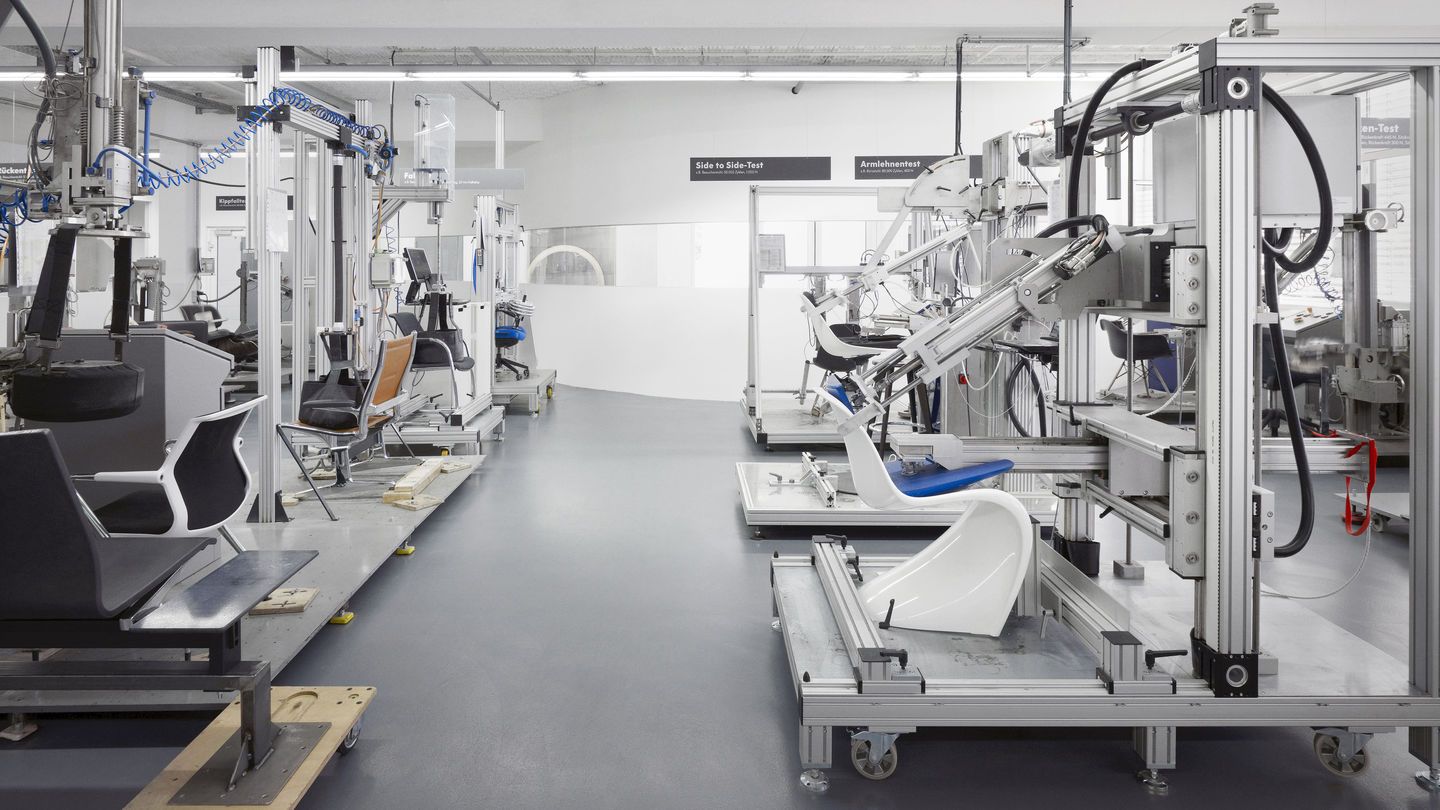Controls: Lever on the bottom left of the seat adjusts to the user's personal weight and provides optimal support throughout the full range of motion. All adjustments can be made while seated, and with just four turns of the knob, you can easily fine-tune from minimum to maximum resistance.
Operation location: Lever on the lower right of the seat Adjust the seat to the appropriate height. The appropriate seat height is when your knees are bent at about a 90° angle and your feet are flat on the floor.
Operation location: Button on the back of the seat The backrest reclining mechanism is set in the locked position for safe transport. Please release the backrest lock function before use.
Simple design is the most complex
The development of Physix began by unraveling the tradition and history of office chairs, starting with the Eames Aluminum Chair, which could be said to be the root of office chairs. From there, we aimed to derive an ergonomic seat and back structure that meets modern needs. It is no exaggeration to say that the structural and design beauty and simplicity of the Eames Aluminum Chair are the ultimate. Charles and Ray Eames brilliantly embodied the idea of forming a seat shell by continuously stretching fabric between two parts running along the sides of the chair. The Eames Aluminum Chair remains a design that can be said to be an icon of office chairs even today. The challenge for Alberto Meda was how to create a comfortable and stable shell structure, while allowing maximum flexibility for posture. As with the Eameses at the time, he explored the possibilities of modern materials and structures, which led him to choose a flexible, high-quality plastic. Following the Eames's idea, he created a structure in which the back and seat are integrated by stretching fabric between two plastic frames. The plastic frame flexes according to the movements of the person sitting on it. Furthermore, the movement is transmitted to the springs through two braces that support the frame under the seat. This allows for a wide range of flexible movements according to the load and even fine adjustments.
The challenge for Alberto Meda was how to create a comfortable and stable shell structure, while allowing maximum flexibility for posture. As with the Eameses at the time, he explored the possibilities of modern materials and structures, which led him to choose a flexible, high-quality plastic. Following the Eames's idea, he created a structure in which the back and seat are integrated by stretching fabric between two plastic frames. The plastic frame flexes according to the movements of the person sitting on it. Furthermore, the movement is transmitted to the springs through two braces that support the frame under the seat. This allows for a wide range of flexible movements according to the load and even fine adjustments.
Alberto Meda

Born in Tremezzina, Italy in 1945, Alberto Meda studied Mechanical Engineering at Milan Polytechnic. He was Technical Director of Kartell from 1972 to 1979 and has worked extensively as a freelance designer for various companies, including Alias, Alessi, Cinelli, Colombo Design, Ideal Standard, Luceplan, Legrand, Mandarina Duck, Omron Japan, Philips and Olivetti. He was a consultant for Alfa Romeo from 1981 to 1985. He studied Industrial Technology at the Domus Academy in Milan from 1983 to 1987. In 1995 he became a lecturer at his alma mater, Milan Polytechnic, and a member of the board of directors of Designlabor Bremerhaven. Since 2003 he has been teaching at the IUAV University of Venice and has lectured in numerous locations, including Chicago, St. Louis, Stockholm, the Boisbucher Workshop, Miami, São Paulo, Ulm, Istanbul and Toronto. Alberto Meda has been collaborating with Vitra since 1994. His functional and elegant office chairs and tables form the core of Vitra's Office Collection.
Vitra develops products and environments
Vitra elevates the quality of homes, offices and public spaces through the power of design. Founded in 1950 and since.

Product and environmental developmentRespect for the environment is expressed in every aspect of Vitra's activities: in the way we develop and manufacture our products, the way we source our raw materials and the way we organize our supply chains. New discoveries lead to further developments. Vitra believes that the environment "shapes" how we think and feel. With the power of design, we work every day to make the environment better.
In developing products that can be used for as long as possible , we avoid short-term trends and eliminate unnecessary elements. If the design, manufacturing method, and materials are not all in place, the product will not last.

Materials Vitra is committed to using materials that meet human rights and environmental standards in accordance with official certification programs for sustainable and responsible sourcing. Products and materials are regularly analysed and assessed by external organisations. 46% of Vitra's suppliers are German and 96% are European. As a globally active company, we produce our products in the most resource-efficient way possible and deliver them to our customers all over the world.
Cultural Activities <br>Vitra is also active in the cultural sector beyond its business activities. It invests a large portion of its profits in preserving cultural heritage in design and architecture, supporting various institutions around the world, such as the Eames Foundation, which preserves the Eames House in Pacific Palisades, California, the Alvar Aalto Foundation in Finland, and the Barragan Foundation in Switzerland.
Furthermore, the Vitra Campus, located on a vast site in Weil am Rhein on the Swiss-German border, is a one-of-a-kind experimental space for architecture and design, and a place where architecture, design and art are open to everyone on an equal footing. The ongoing development of the Vitra Campus is also a sign of our mutual, long-term relationship with the region of Weil am Rhein.












































